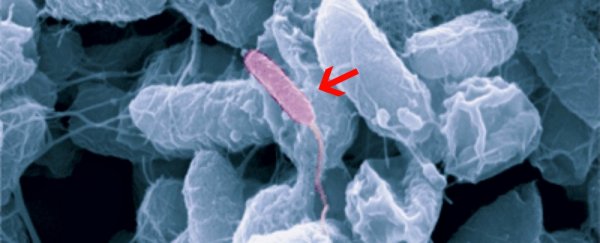Researchers in the US have discovered a brand new life form hiding inside our saliva – a type of parasitic bacteria that relies on other bacterium to live.
The bacterium only has 700 genes and is the first strain ever discovered that's completely dependent on other bacteria for survival. If that wasn't creepy enough, this new life form has also been linked to a whole range of human diseases, including gum disease, cystic fibrosis, and antimicrobial resistance.
The new parasite, which is yet to be formally named, was discovered after scientists from the University of Washington School of Dentistry discovered a mysterious fragment of RNA in human saliva tests that didn't match any known organisms.
Other labs had found the same strange RNA code in the past, but no one had been able to figure out where it came from. But after studying it more closely, the team was able to show that this RNA belonged to a tiny bacterium that's actually living on another, better known strain: Actinomyces odontolyticus.
Although scientists have found bacteria that can infect other bacteria in the past, this is the first time they've ever discovered a strain that's entirely dependent on infecting its host, because it can't make its own amino acids that are essential for life.
That's why it was so hard for scientists to identify it - they can't grow it and keep it alive in the lab without a host.
"They're ultra-small bacteria, and live on the surface of other bacteria," lead researcher Jeff McLean told the annual meeting of the American Society for Microbiology in Boston last week, as Andy Coghlan reports for New Scientist.
By studying the parasite in the lab alongside its host, the team has now shown that the new type of bacteria hunts down Actinomyces and attaches to its outer membrane.
At first, Actinomyces can handle the parasites, which suck the nutrients out of it. But eventually it succumbs and is killed by the attack. The team still isn't sure how the newly discovered bacteria reproduces and spreads to its next victim.
"We're trying to decipher what's going on," said lead researcher Jeff McLean.
But what the team is now interested in is how the new life form might affect human disease - they found high concentrations of the parasite's DNA in people with gum disease and cystic fibrosis.
Previous research has shown that Actinomyces odontolyticus contributes to gum disease, and when the new parasite is added, it seems to make Actinomyces better able to evade white blood cells, which of course means the body is less capable of fighting off the infection.
The host bacterium also become more resistant to the antibiotic streptomycin too, the researchers found.
They'll now be investigating the relationship further, to try to figure out how the presence of the parasitic bacterium might affect human health, and how we can use this knowledge to improve disease outcomes.
While McLean and his colleagues have presented their findings to the annual meeting of the American Society for Microbiology, it hasn't been peer-reviewed as yet, so we need to wait for other researchers to confirm the discovery. But scientists are already pretty excited about it.
Geobiologist Roland Hatzenpichler from the California Institute of Technology, who wasn't involved in the study, told New Scientist it could be the "tip of the iceberg" for microbes like this.
And it's unlikely to be the last discovery to come from the saliva in our mouths, as scientists think as many as half the microbes in our spit are yet to be properly identified.
"It's incredibly exciting to see such a major advancement in the study of major lineages of life that until now have been impossible to cultivate," Brian Hedlund from the University of Nevada in Las Vegas, who also wasn't involved in the study, told New Scientist.
"Gene data from other as-yet uncultivated organisms suggests that host-parasite relationships between microbes are common in nature, so this type of study is a great template for others to follow."
